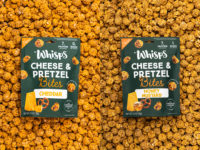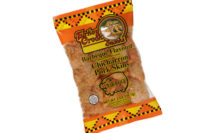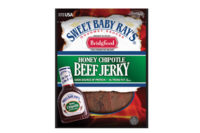As more consumers continue to discover the nutritional benefits and great taste of today’s jerky and meat snacks, the outlook for the category looks bright.
Demand for jerky and meat snacks continues to grow, as consumers of all ages and walks of life seek out snacks and meal replacers made from healthier and fewer ingredients, low-calorie, low in fat and carbohydrates and protein-rich. These products also offer people a selection of unique, satisfying flavors. No wonder data gathered by IRI, a Chicago-based research firm, reveals that jerky sales have jumped approximately $124.7 million in the past year ($1.28 billion from the 52 weeks ended April 20, 2014, up from $1.16 billion for the 52 weeks ended April 21, 2013).
“This is an incredibly exciting time for the [jerky] category,” says Erik Havlick, vice president of sales at Boulder, CO-based Thanasi Foods LLC, which makes Duke’s Small Batch Smoked Meats. “More than ever, you see the category becoming clarified, as brands take their unique positions in order to speak to specific consumer needs and wants—whether you are talking about the protein craze, the ‘real food’ movement or the craft/artisanal obsession. The result is a kind of renaissance for the category.”
Supporting the craft of great smoked meats
Thanasi Foods’ Duke’s Small Batch Smoked Meats line features beef jerky in five flavors (Original, Cracked Pepper, Honey Bourbon, Island Teriyaki and Roasted Cayenne); steak, beef brisket and pork strips; and “Shorty” Smoked Sausages.
“There’s a growing consumer segment that equates the notion of ‘craft’ with [attributes] like ‘quality’ and ‘better-for-you,’ and wants to have a deeper connection with the brands and the artisanship behind them,” notes Havlick. “That’s why Duke’s isn’t just about great beef jerky—it’s about supporting the craft of great smoked meats.”
Kevin Papacek, director of marketing, Jack Link’s Beef Jerky, Minong, WI, attributes “very strong” jerky and meat snack sales the past several years to similar trends. “Much of this is due to the increase in snacking in America,” he says. “Snacking accounts for one in five of all eating occasions, [according to NPD’s ‘Snacking in America’ report]. Additionally, 53% of Americans are looking to add protein to their diet, [according to NPD’s ‘Functional Foods & Beverage’ custom survey].
“In addition, innovative flavors and new proteins are bringing new consumers into the category. We remain at the forefront of that growth by leading these trends.”
In January, Jack Link’s launched Sweet Teriyaki Turkey Jerky, which capitalizes on both the alternative protein and innovative flavor trends. The product has solid strips of lean, white turkey breast with teriyaki and sesame seeds. It’s 98% fat-free with no added monosodium glutamate (MSG), high in protein, low in calories and carbs, and comes in a resealable package.
Flavor innovation, excitement
Later this summer, the company will launch its limited-edition Wild Side flavors: Jack Link’s Chili Lime Beef Jerky; and Jack Link’s Kung Pao Beef Jerky.
“Over the years, we have expanded our product lineup to appeal to a broader audience,” says Papacek. “By introducing new product lines, our primary consumer base has expanded. Not only do we appeal to our core male demographic, but to active and health-conscious males and females. This has led to growth for our organization.”
Jon Sebastiani, founder of KRAVE Jerky, Sonoma, CA, believes, too, that today’s “jerky space is filled with innovation, excitement and growth.” For the past 30 to 40 years, he says, a “cowboy-and-Indian approach” dominated the category. Due to a lot of innovation by jerky manufacturers—especially in flavor profiles—that’s changing.
And KRAVE Jerky is certainly doing its part to offer consumers interesting flavor profiles. “We have flavors like Basil Citrus, Sweet Chipotle, Black Cherry Barbecue—flavors with nuanced differences that give the product a different flair,” Sebastiani points out. “People like to explore flavors. That’s why we like to eat at restaurants. It’s enjoyable to explore different flavor combinations. In a category largely dominated by pepper, teriyaki and original, we now have the freedom and creativity of bringing different flavors to different kinds of meat.”
The company currently offers beef, turkey and pork jerky, but Sebastiani sees bison, salmon and tuna in the company’s future. “There are other companies that already do that,” he says. “There’s a lot of creativity in meat sources as well as in flavor profiles.”
Bring on the cabernet
Last month, KRAVE Jerky launched a flavorful jerky line called KRAVE Artisanal at Whole Foods Markets. “We’ve gone even more creative in terms of the flavor profiles,” says Sebastiani. “We have flavors like Cabernet Rosemary, Sesame Ginger, Chardonnay Thyme and Honey Peach Barbecue.” Like all KRAVE’S products, the new items are made with Global Animal Partnership-rated meats. GAP encourages higher welfare practices and systems to the benefit of farmers, consumers, retailers and the animals.
“We’re really trying to bring new users into the category via re-education by focusing on the health benefits [of jerky],” explains Sebastiani. “While we’re definitely experiencing the typical buyer who’s been buying jerky for some time, and we’re focusing on drawing women into category…bringing moms in who want their children to have protein.”
Paul E. Anthony, vice president, Blackjack Beef Jerky, Chickasha, OK, which launched in April 2013, says that “with the trend toward healthy snacks and limited [or no] preservatives, people are migrating from traditional snack items to high-protein alternatives. Currently, the beef jerky/meat snacks segment has only about a 40% household saturation margin. This allows for significant growth in the sector in the coming years.”
The company’s Blackjack Beef Jerky is designed to appeal to consumers seeking preservative-free, high-protein snacks. Available in 1.5- and 4-oz. bags, the product is 100% preservative-free, and contains no nitrates, sorbate or monosodium glutamate (MSG). Each serving has 11 g. of protein, 45 calories and no carbohydrates. “We are focusing on offering a traditional beef jerky made from lean whole muscle slices of beef, simple ingredients and minimal processing,” Anthony explains.
Where’s the beef…alternative?
No matter how healthy the jerky, beef isn’t the meat of choice for a growing number of jerky buyers. “Jerky producers have to pivot away from beef,” says Jeff Weber, brand manager, Old Wisconsin, Sheboygan, WI. “You see more pork and other non-beef protein products. I think that plays well to turkey.”
Old Wisconsin Honey Turkey Snack Bites joined the company’s product line last fall. “We’ve had some very good success with our Original Turkey Snack Bites,” explains Weber. “The Honey Turkey Snack Bites is a line extension of that. It’s now available nationally.”
Old Wisconsin also offers Beef and Pepperoni Snack Bites; Original, Turkey, Beef and Pepperoni Snack Sticks; beef and cheese Smokestacks; and sausage. The turkey products have fewer calories and less fat than the beef products, are gluten-free and have no carbohydrates, attributes that female consumers typically seek out. Smaller bites and a slight sweetness also make them more appealing to teens and children. Young men are the primary purchasers of Old Wisconsin products at convenience stores.
Monogram Food Solutions LLC also offers several non-beef snacks to meet growing consumer demand for such products. The Memphis, TN, company launched Butterball turkey jerky, sticks, apple nuggets and snack stick boxes in May 2013. Last month, it introduced Maple Glazed Bacon Jerky in a resealable pouch under the Trail’s Best, Wild Bill’s, Johnsonville and Bass Pro Uncle Buck’s brands.
According to Marty Butler, vice president of marketing/business development, the company’s target market is 18- to 54-year-olds. “We target both men and women by offering products that appeal to both groups,” he explains. “For example, our new Butterball meat snacks appeal to women looking for low-fat, lean and high-protein snack options.”
No doubt, these consumers are also impacting some of the emerging category trends Butler is seeing, such as extreme flavors, unique flavor combinations like fruit and barbecue, fruit-infused products and artisanal jerky.
Against the current
Chicken, turkey and pork aren’t the only up-and-comers in the jerky and meat snacks category. “One of the biggest trends is the movement toward alternative proteins like chicken, turkey and salmon,” says Gabriel Viteri, vice president of strategy and business development, Acme Smoked Fish Corp., Brooklyn, NY, which produces Ruby Bay Salmon Jerky. Viteri adds that the clean-label and natural-products movement are equally important.
To penetrate marketplaces that offer convenience and a retail price point, the company recently introduced Ruby Bay single-serve jerky strips, made from wild-caught Alaskan king salmon in Teriyaki, Pepper and Orange-Ginger flavors. The hand-cut jerky strips are packed with 9 g. of protein per serving. “Salmon jerky has about 20% more protein that beef jerky and has naturally occurring Omega 3 fatty acids,” Viteri says. “Salmon jerky is a strong contender for jerky eaters looking for a healthy, all-natural, high-protein and low-fat alternative.”
Jerky is subject to the same macro trends that other food products are, contends Tom Sunderland, vice president of marketing, Ocean Beauty Seafoods LLC, Seattle, which produces Ocean Beauty Salmon Jerky as well as other canned, smoked and fresh seafood. “Specifically, the current consumer trends for simple, alternative, sustainable proteins; the trend of people adopting ‘flexitarian’ diets, in which they significantly reduce meat consumption without becoming vegetarians; and increased consumption of high-protein snacks, all lead toward the conclusion that the time is right for jerky made from nontraditional protein sources, such as poultry and fish,” he says.
To that end, the company introduced three flavors of wild salmon jerky under the Ocean Beauty brand. Available in Original, Teriyaki and Black Pepper varieties, it’s made from sustainable wild Alaska salmon. “The nutritional profile of these jerkys is nearly identical to beef, except that salmon has roughly 50 times the Omega 3s of beef,” says Sunderland.
The company’s target market is jerky consumers looking for a simple and sustainable alternative to beef. “We believe that salmon jerky has an audience wherever beef jerky is sold,” he adds, “but we also believe that the best demographic for it is consumers who are active and health-conscious.”
Packaging improvements
To promote their products’ healthy attributes, better-for-you ingredients and unique flavors and appeal more to first-time buyers, many jerky and meat snack manufacturers are updating their product packaging.
“We wanted Duke’s Small Batch Smoked Meats packaging to reflect the spirit of our brand: Transparent; accessible; [and] with a ‘simpler is better’ ethic,” says Havlick. “We’re proud of our product, and increased the window size to show the consumer more of our product. We also maintain the promise that ‘there are no secrets between friends.’ We tell the consumer right on our bags the simple steps to making great beef jerky.”
The bag is nominally wider—about one-half inch than the standard size of the category—but this small concession makes a big difference for the consumer as it relates to ease of use, he adds. “People can comfortably reach into a bag of Duke’s for their next bite. And as far as ‘simpler is better,’ our Nutrition Facts panel and ingredient decks are short, simple and [feature] ingredients you can actually pronounce.”
Papcek says, too, that Jack Link’s designs its packaging to be easily accessible to consumers, due to purchase behavior in a category where product sales are often impulse-driven. “Studies show that 23% of all meat snacks are consumed within 30 minutes of purchase,” he says. “This is why many retailers feature meat snacks prominently in high-traffic areas, such as checkouts and secondary displays. The reason we are the number-one brand in [convenience] stores has a lot to do with convenience and on-the-go snacking being a never-ending trend.”
Resealable packaging is now a standard, says Old Wisconsin’s Weber, adding that the company’s 4-oz. and larger bags have resealable zipper closures. Individual items are sealed in easy-peel film.
Butler says Monogram Food Solutions also uses consumer-friendly, easy-peel packaging film for its snack sticks and has added nutrition callouts on the front of its packages to better communicate key nutrition facts to consumers.
Meanwhile, Ocean Beauty Seafoods’ packaging features Spanish and English text. The bags are also resealable and peggable, and have a 12-month shelf life after manufacture, according to Sunderland.
The challenges
Like most snack producers, jerky and snack meat manufacturers face a variety of challenges when producing and marketing their products. Perhaps the most significant is increasing meat costs, especially for beef.
“Beef is up 27% since the start of the year alone,” says Havlick. “It takes about 1 lb. of fresh beef to make 6 oz. of jerky, so the fact is that jerky, by default, is an expensive category. I feel this clarifies the field even further: You are either a low-cost provider; or you have a truly differentiated brand that can help graduate the consumer to the new price reality.
“What I find dangerous is that so many brands are reacting by investing in deep price promotions. That tactic resets the consumer price expectation to a level that’s simply unsustainable. This is why we feel the category is not only ripe for ‘premiumization,’ but that its long-term health depends upon it. It’s why we choose to resist commoditization and instead invest more in what makes us special and unique: Proudly crafting our smoked meats with all-natural ingredients, in small batches, right here in the U.S.”
Sebastiani agrees: “The cost of protein is through the roof. We buy all U.S. meat, and we use whole-muscle cuts, so we’re buying the top cut of the cow. It takes 2 lb. of raw to make 1 lb. of jerky, so the costs are huge. The challenge for the category is [consumer] willingness to pay. If prices get too high, customers might abandon jerky and go back to a bar, a bag of pretzels or something else.”
Anthony also cites rising beef costs and consumers’ willingness to pay higher prices as category concerns. “The rising cost of USA-produced beef has narrowed margins at the manufacturing level,” he says. “Ultimately, there’s a threshold that consumers will opt for lower-quality alternatives in the segment, or away from the meat snacks segment all together.”
Acme Smoked Fish Corp.’s Viteri, on the other hand, finds limited supply—especially on the company’s salmon category, where only premium salmon can be used—a challenge.
For Papacek, the biggest challenge is changing consumer perceptions on the benefits of jerky. “There’s a growing emphasis on the importance of satiety and protein,” he says. “Our products are made from lean meat, which is the most authentic protein you can get from a snack. Consumers also get the added benefits of low calories, fat and carbohydrates. They’re seeking protein-rich snacks because they want to feel full longer and Jack Link’s is a perfect satiating snack that hits those needs.”
Butler says continuing to grow the category and bringing new users to it is also important. “That’s why we introduced innovative new products like bacon jerky and Butterball turkey meat snacks,” he explains. “They provide added variety and can help attract new users to the meat snack category.”
Bringing new customers to the category can be difficult, given all the other snack products on the market. “When our Old Wisconsin products sit on the shelf, they have to compete with baked snacks, salted snacks, trail mix, confection and more,” says Weber. “Obviously, you have to be worried about [other jerky brands], but there are so many other snacking options now.
“I do think that the meat snack category can do a better job of promoting protein in our products. Animal protein is the most digestible protein there is. Some bars certainly do have good value in terms of grams of protein, synthetic or grain-based. And there’s the assumption that some of these products are healthy. If you look closely, any incremental amount of protein is [imaginary]. And then there’s the sugar and other things.”
A bright future
Despite rising meats costs, competition from other snack categories and negative consumer perceptions, the jerky and meat snack manufacturers participating in this article have a positive outlook for the category.
“The future of meat snacks is looking bright,” says Papacek. “The research and development team at Jack Link’s is always looking into opportunities for growth, assessing the options and making the most appropriate decisions for our brand and the category…It’s very important to continually be innovative and come out with new items that will expand our consumer base, growing the category. There are plenty of salty snacks choices, so it’s essential to differentiate from other brands and products.”
Butler concurs: “The outlook is very bright for the meat snack category. The inherent, positive nutrition profile of jerky—lean, nutritious and low fat—will continue to provide consumers with healthier snacks, especially in comparison to many of the other snack options like chips, cookies and candy.”
Industrywide, the outlook is strong and optimistic, says Anthony, citing the more educational opportunities for jerky manufacturers as more women embrace meat products. “The large, untouched market penetration per household reflects a huge window of opportunity,” he notes.
“Consumers want to know more about their choices, feel better about what they’re purchasing and eating, and go deeper with their brands,” concludes Thanasi Foods’ Havlick. “The [jerky] category will be more relevant than ever if we can break out of its traditional boundaries and actually catch up to where the consumer is today.”











